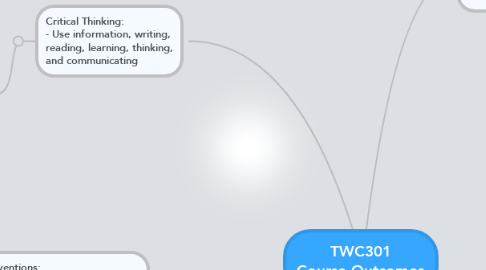TWC301 Course Outcomes
by kelsey eikren


1. Critical Thinking: - Use information, writing, reading, learning, thinking, and communicating
1.1. Chapter 1: - The six design principles will need critical thinking in each principle to complete them. The six design principles are emphasis, contrast, balance, alignment, repetition, and flow.
1.1.1. Chapter 2:
2. Knowledge of Conventions: - learn common formats for different genes - understand legal and ethical uses in technology
2.1. Chapter 1: - To understand the common formats, it is important to know who the audience is. If the audience is large group of people something like a poster or a banner will effectively portray the message. If the audience is for a small group or an individual a pamphlet or newspaper ad is more appropriate. Knowing who the audience is will convey how much information to include within the format chosen.
2.1.1. Chapter 2: The emphasis techniques are helpful formats. Making the emphasis the biggest, brightest, boldest is important. Adding texture, color contrast, border, etc. is also beneficial for emphasizing.
3. Rhetorical Knowledge: - Identify and focus on a defined purpose - Respond appropriately - Understand the role of a variety of technologies and use them appropriately
3.1. Chapter 1: The four important basics of beginning a design or layout are the purpose, the audience, the page format, and an understand of the basic knowledge of design principles. You must find what to say to your specified audience and how to prepare it in a way that is easily and quickly readable.
3.1.1. Chapter 2: The first important tip for emphasis is, don't put your readers to sleep. Understanding the difference between emphasis and contrast helps to focus on the content of the message and which parts of the message are most important.
4. Processes: - be aware of drafts and revisions - develop strategies for revising & editing
4.1. Chapter 1: - An understand of the six design principles will help to begin, work, and complete the design proves. The first step in the design process begins after receiving the design project assignment. Once received you can research the problem. The second step is to generate ideas by creating thumbnail sketches. The third step is step is to select the the strongest thumbnails and turn them into roughs to begin refining the layout and the overall concept.
4.1.1. Chapter 2: The processes to find what to emphasize first and last is done through visual hierarchy. Knowing what needs to be emphasized the most will help to discover the focal point and the accents on the page.
